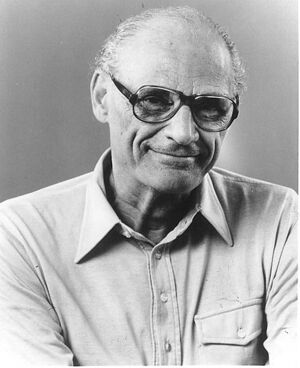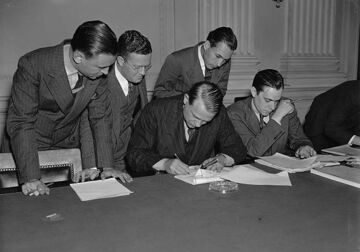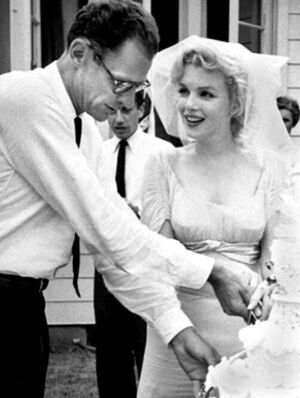Arthur Miller
(Playwright, Essayist) | |
|---|---|
 | |
| Born | Arthur Asher Miller 1915-10-17 Harlem, New York, U.S. |
| Died | 2005-02-10 (Age 89) Roxbury, Connecticut, U.S. |
| Nationality | American |
| Alma mater | University of Michigan |
| Children | 4 |
US playwright blacklisted by Hollywood | |
Arthur Asher Miller (October 17, 1915 – February 10, 2005) was an American playwright and essayist in the 20th-century American theater. Among his most popular plays are All My Sons (1947), Death of a Salesman (1949), The Crucible (1953), and A View from the Bridge (1955, revised 1956). He wrote several screenplays and was most noted for his work on The Misfits (1961). The drama Death of a Salesman has been numbered on the short list of finest American plays in the 20th century.
Contents
Father Charles E. Coughlin
Miller held left-wing opinions and was horrified by the views expressed by Charles E. Coughlin on the radio. "Father Charles E. Coughlin, who by 1940 was confiding to his ten million Depression-battered listeners that the president was a liar controlled by both the Jewish bankers and, astonishingly enough, the Jewish Communists, the same tribe that twenty years earlier had engineered the Russian Revolution... He was arguing... that Hitlerism was the German nation's innocently defensive response to the threat of Communism, that Hitler was only against 'bad Jews', especially those born outside Germany."[1]
HUAC and Hollywood Blacklisting
In 1952, Elia Kazan appeared before the House Un-American Activities Committee (HUAC). Kazan named eight members of the Group Theatre, including Clifford Odets, Paula Strasberg, Lillian Hellman, J. Edward Bromberg, and John Garfield,[2] who in recent years had been fellow members of the Communist Party.[3] Miller and Kazan were close friends throughout the late 1940s and early 1950s, but after Kazan's testimony to the HUAC, the pair's friendship ended. After speaking with Kazan about his testimony, Miller traveled to Salem, Massachusetts, to research the witch trials of 1692. He and Kazan did not speak to each other for the next ten years. Kazan later defended his own actions through his film On the Waterfront, in which a dockworker heroically testifies against a corrupt union boss.[4] Miller would retaliate to Kazan's work by writing A View from the Bridge, a play where a longshoreman ousts his co-workers motivated only by jealousy and greed. He sent a copy of the initial script to Kazan and when the director asked in jest to direct the movie, Miller replied "I only sent you the script to let you know what I think of Stool-Pigeons."
In The Crucible, Miller likened the situation with the House Un-American Activities Committee to the witch hunt in Salem in 1692.[5][6] The play opened at the Martin Beck Theatre on Broadway on January 22, 1953. Though widely considered only somewhat successful at the time of its release, today The Crucible is Miller's most frequently produced work throughout the world.

The HUAC took an interest in Miller himself not long after The Crucible opened, denying him a passport to attend the play's London opening in 1954. When Miller applied in 1956 for a routine renewal of his passport, the House Un-American Activities Committee used this opportunity to subpoena him to appear before the committee. Before appearing, Miller asked the committee not to ask him to name names, to which the chairman, Francis E. Walter (D-PA) agreed.[7] When Miller attended the hearing, to which Monroe accompanied him, risking her own career, he gave the committee a detailed account of his political activities.[8] Reneging on the chairman's promise, the committee demanded the names of friends and colleagues who had participated in similar activities. Miller refused to comply, saying "I could not use the name of another person and bring trouble on him."[9]
As a result, a judge found Miller guilty of contempt of Congress in May 1957. Miller was sentenced to a fine and a prison sentence, blacklisted, and disallowed a US passport.[10] In August 1958, his conviction was overturned by the court of appeals, which ruled that Miller had been misled by the chairman of the HUAC. The Hollywood Blacklist was lifted in 1960.
Miller's experience with the HUAC affected him throughout his life. In the late 1970s, he joined other celebrities (including William Styron and Mike Nichols) who were brought together by the journalist Joan Barthel. Barthel's coverage of the highly publicized Barbara Gibbons murder case helped raise bail for Gibbons' son Peter Reilly, who had been convicted of his mother's murder based on what many felt was a coerced confession and little other evidence.[11] Barthel documented the case in her book A Death in Canaan, which was made as a television film of the same name and broadcast in 1978.[12] City Confidential, an A&E Network series, produced an episode about the murder, postulating that part of the reason Miller took such an active interest (including supporting Reilly's defense and using his own celebrity to bring attention to Reilly's plight) was because he had felt similarly persecuted in his run-ins with the HUAC. He sympathized with Reilly, whom he firmly believed to be innocent and to have been railroaded by the Connecticut State Police and the Attorney General who had initially prosecuted the case.
Marriage to Marilyn Monroe
In June 1956, Miller left his first wife, Mary Slattery, whom he had married in 1940, and wed film star Marilyn Monroe. They had met in 1951, had a brief affair, and remained in contact since. Monroe had just turned 30 when they married; she never had a real family of her own and was eager to join the family of her new husband.[13]
Monroe began to reconsider her career and the fact that trying to manage it made her feel helpless. She admitted to Miller, "I hate Hollywood. I don't want it anymore. I want to live quietly in the country and just be there when you need me. I can't fight for myself anymore."[14]
She converted to Judaism to "express her loyalty and get close to both Miller and his parents", writes biographer Jeffrey Meyers. Monroe told her close friend, Susan Strasberg: "I can identify with the Jews. Everybody's always out to get them, no matter what they do, like me." Soon after she converted, Egypt banned all of her movies.
Miller began work on writing the screenplay for The Misfits in 1960, directed by John Huston and starring Monroe. But it was during the filming that Miller and Monroe's relationship hit difficulties, and he later said that the filming was one of the lowest points in his life.[15] Monroe was taking drugs to help her sleep and more drugs to help her wake up, which caused her to arrive on the set late and then have trouble remembering her lines. Huston was unaware that Miller and Monroe were having problems in their private life. He recalled later, "I was impertinent enough to say to Arthur that to allow her to take drugs of any kind was criminal and utterly irresponsible. Shortly after that I realized that she wouldn't listen to Arthur at all; he had no say over her actions."[16]
Shortly before the film's premiere in 1961, Miller and Monroe divorced after their five years of marriage. Nineteen months later, August 5, 1962, Monroe died of a likely drug overdose.[17] Huston, who had also directed her in her first major role in The Asphalt Jungle in 1950, and who had seen her rise to stardom, put the blame for her death on her doctors as opposed to the stresses of being a star: "The girl was an addict of sleeping pills and she was made so by the God-damn doctors. It had nothing to do with the Hollywood set-up."[18]
Miller married photographer Inge Morath in February 1962. She had worked as a photographer documenting the production of The Misfits. The first of their two children, Rebecca, was born September 15, 1962. Their son, Daniel, was born with Down syndrome in November 1966. Against his wife's wishes, Miller had him institutionalized, first at a home for infants in New York City, and then at the Southbury Training School in Connecticut. Though Morath visited Daniel often, Miller never visited him at the school and rarely spoke of him.[19][20] Miller and Inge remained together until her death in 2002. Arthur Miller's son-in-law, actor Daniel Day-Lewis, is said to have visited Daniel frequently, and to have persuaded Arthur Miller to meet with him.
References
- ↑ https://spartacus-educational.com/USAmillerA.htm
- ↑ http://www.moderntimes.com/palace/kazan/
- ↑ https://web.archive.org/web/20060923064612/http://www.pbs.org/wnet/americanmasters/database/kazan_e.html
- ↑ https://www.loc.gov/programs/static/national-film-preservation-board/documents/on_the_waterfront.pdf
- ↑ For a frequently cited study of Miller's use of the Salem witchcraft episode, see Robert A. Martin, "Arthur Miller's The Crucible: Background and Sources", reprinted in James J. Martine, ed. (1979) Critical Essays on Arthur Miller, G. K. Hall
- ↑ https://web.archive.org/web/20060910085108/http://www.writing.upenn.edu/~afilreis/50s/miller-mccarthyism.html
- ↑ http://news.bbc.co.uk/onthisday/hi/dates/stories/august/7/newsid_2946000/2946420.stm
- ↑ https://partners.nytimes.com/books/00/11/12/specials/miller-front.html
- ↑ http://news.bbc.co.uk/onthisday/hi/dates/stories/august/7/newsid_2946000/2946420.stm
- ↑ http://www.umich.edu/~amfiles/biography/earlycareer.html
- ↑ Barthel, Joan:A Death in Canaan. New York: E.P. Dutton. 1976
- ↑ https://www.imdb.com/title/tt0077412/
- ↑ Meyers, Jeffrey. The Genius and the Goddess: Arthur Miller and Marilyn Monroe. University of Illinois Press (2010) page 156
- ↑ Meyers, Jeffrey. The Genius and the Goddess: Arthur Miller and Marilyn Monroe. University of Illinois Press (2010) page 154
- ↑ https://www.today.com/popculture/new-footage-marilyn-monroe-clark-gable-revealed-wbna24927803
- ↑ Grobel, Lawrence. The Hustons, Charles Scribner's Sons, New York (1989) p. 489
- ↑ https://www.history.com/this-day-in-history/marilyn-monroe-is-found-dead
- ↑ Badman, Keith. The Final Years of Marilyn Monroe: The Shocking True Story, Aurum Press (2010) ebook, ISBN 9781781310519
- ↑ https://www.vanityfair.com/culture/2007/09/miller200709
- ↑ Joseph Epstein (November 29, 2011). Gossip: The Untrivial Pursuit. HMH. pp. 35–37 page 35-37
